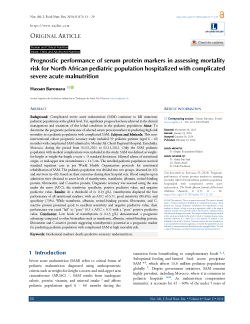Prognostic performance of serum protein markers in assessing mortality risk for North African pediatric population hospitalized with com-plicated severe acute malnutrition
Abstract
Background: Complicated severe acute malnutrition (SAM) continues to kill numerous pediatric populations at the global level. Yet, significant progress has been achieved in the clinical management and treatment of this lethal condition in the pediatric population.
Aims: To determine the prognostic performance of selected serum protein markers in predicting high-risk mortality in a pediatric population with complicated SAM.
Subjects and Methods: This non-interventional cohort prognostic accuracy study included 59 pediatric patients (aged 6 – 60 months) with complicated SAM admitted to Moulay Ali Cherif Regional Hospital, Errachidia, Morocco, during the period from 01.02.2021 to 02.11.2022. Only the SAM pediatric population with medical complications were included in the study. SAM was defined as weight-for-height or weight-for-length z-score < -3 standard deviations, bilateral edema of nutritional origin, or mid-upper arm circumference < 11.5 cm. The enrolled pediatric population received standard inpatient care as per World Health Organization protocols for nutritional rehabilitation of SAM. The pediatric population was divided into two groups, deceased (n=10) and survivors (n=49), based on their outcomes during their hospital stay. Blood samples upon admission were obtained to assess levels of transthyretin, transferrin, albumin, retinol-binding protein, fibronectin, and C-reactive protein. Diagnostic accuracy was assessed using the area under the curve (AUC), the sensitivity, specificity, positive predictive value, and negative predictive value.
Results: At a threshold of (≤ 0.13 g/L), transthyretin displayed the best performance of all nutritional markers, with an AUC of 0.71, good sensitivity (80.4%), and specificity (73%). While transferrin, albumin, retinol-binding protein, fibronectin, and C-reactive protein presented good to excellent sensitivity and negative predictive value, their performance was rated “fail” to “poor” (0.5 ≤ AUC < 0.7) with a “poor” positive predictive value.
Conclusion: Low levels of transthyretin (≤ 0.13 g/L) demonstrated a prognostic advantage compared to other biomarkers such as transferrin, albumin, retinol-binding protein, fibronectin and C-reactive protein suggesting transthyretin's potential as a prognostic marker for predicting pediatric population with complicated SAM at high mortality risk.
Keywords: biochemical markers, death, predictive accuracy, undernutrition.
Full text article
Authors
Copyright (c) 2024 Hassan Barouaca

This work is licensed under a Creative Commons Attribution 4.0 International License.
-
Attribution — You must give appropriate credit, provide a link to the license, and indicate if changes were made. You may do so in any reasonable manner, but not in any way that suggests the licensor endorses you or your use.
-
No additional restrictions — You may not apply legal terms or technological measures that legally restrict others from doing anything the license permits.





